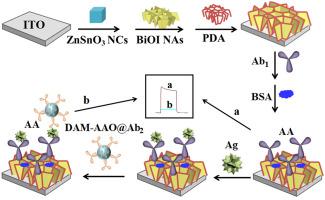Analytica Chimica Acta ( IF 5.7 ) Pub Date : 2022-06-16 , DOI: 10.1016/j.aca.2022.340095 Yu Du 1 , Siqi Yu 2 , Zhaohui Li 3 , Huangxian Ju 2

|
This work designs a competitive consumption strategy of surface electron donor and light absorption for quenching the photocurrent of ZnSnO3 nanocubes/BiOI nanoarrays/polydopamine (ZnSnO3 NCs/BiOI NAs/PDA) as a photoactive material. This material can be formed on electrode surface by successive coating and deposition to provide a substrate for immobilization of capture antibody, and producing strong photocurrent in the presence of ascorbate acid as a surface electron donor due to the well matching structure of band gaps between ZnSnO3 NCs and BiOI NAs, the excellent light absorption ability and high photo-electron conversion efficiency of BiOI NAs and PDA, and the accelerated electron transfer. Using ascorbate oxidase loaded dopamine-melanin nanosphere (DAM-AAO) as a label of the signal (secondary) antibody, the sandwich-type immunoreaction leads to dual photocurrent quenching of the label through the competitive consumption of ascorbate acid with enzymatic oxidation and the light absorption by DAM nanosphere. Thus, a sensitive “On-Off” photoelectrochemical (PEC) immunosensing method is constructed for the analysis of neuron specific enolase (NSE). The proposed method shows a detection range of 0.1 pg/mL −50 ng/mL and a detection limit of 0.03 pg/mL. The excellent performance and the recovery text demonstrated the practicability of the designed strategy and label in immunoassay of different protein biomarkers.
中文翻译:

通过竞争性消耗表面电子供体和光吸收实现光电流猝灭用于免疫传感
这项工作设计了一种表面电子供体和光吸收的竞争消耗策略,用于淬灭作为光活性材料的 ZnSnO 3纳米立方体/BiOI 纳米阵列/聚多巴胺 (ZnSnO 3 NCs/BiOI NAs/PDA) 的光电流。这种材料可以通过连续的涂覆和沉积在电极表面形成,为捕获抗体的固定提供基底,并在抗坏血酸作为表面电子供体的情况下,由于ZnSnO 3之间带隙的良好匹配结构,产生强光电流。NCs和BiOI NAs,BiOI NAs和PDA优异的光吸收能力和高光电子转换效率,加速电子转移。使用负载抗坏血酸氧化酶的多巴胺-黑色素纳米球(DAM-AAO)作为信号(二级)抗体的标记,夹心型免疫反应通过抗坏血酸与酶促氧化和光的竞争消耗导致标记的双重光电流猝灭。 DAM 纳米球的吸收。因此,构建了一种灵敏的“开-关”光电化学 (PEC) 免疫传感方法,用于分析神经元特异性烯醇化酶 (NSE)。所提出的方法显示出 0.1 pg/mL -50 ng/mL 的检测范围和 0.03 pg/mL 的检测限。











































 京公网安备 11010802027423号
京公网安备 11010802027423号